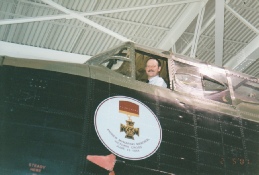Therefore, on 1 May 2001, a team of 3 of the Squadron staff set off for Toronto: myself as the Squadron Commander, Keith Hildred who had done all of the research, and the Squadron’s youngest pilot, Flight Lieutenant Simon Batt who, at the age of 24, was some 80 years Henry’s junior.
Arriving in Toronto, we were met by a representative of the Military Gallery and were royally hosted. A VIP visit had been arranged for us to the Canadian Warplane Heritage Museum at Hamilton International Airport, which Henry had visited as a guest of honour on numerous occasions.
The Canadian Warplane Heritage Museum was founded in 1972 and is a non-
Click here to visit the Canadian Warplane Heritage’s website (this will open in a new window):
Sadly, there were no copies of Robert Taylor’s  ‘The Dambusters’ to be found in the Gallery, but the highlight of an absolutely outstanding day was most definitely the opportunity to ‘crew in’ to the Museum’s Avro Lancaster X, VR-
‘The Dambusters’ to be found in the Gallery, but the highlight of an absolutely outstanding day was most definitely the opportunity to ‘crew in’ to the Museum’s Avro Lancaster X, VR-
The restoration of the Lancaster had been the Museum’s most ambitious restoration project. Originally, this aircraft had stood guard over the Royal Canadian Legion Branch 109 in Goderich, Ontario for many years. With the support of the Sulley Foundation, the Lancaster was acquired by Canadian Warplane Heritage in 1977.
There was a tremendous amount of work required to remove the Lancaster from its concrete pedestal and prepare it for transport to Hamilton. The aircraft arrived at the museum in 1979 and restoration began. However, it was not until 1988, that the Lancaster, dedicated to Andrew Mynarski, VC, would fly in front of 20,000 visitors.
On leaving the Museum, however, our immersion in the Canadian’s air history was in no way complete. Our hosts were, understandably, tremendously proud on their WWI flying ace, Billy Bishop. Credited with some 72 victories, Bishop was the highest-



Balloon Buster 100 -







